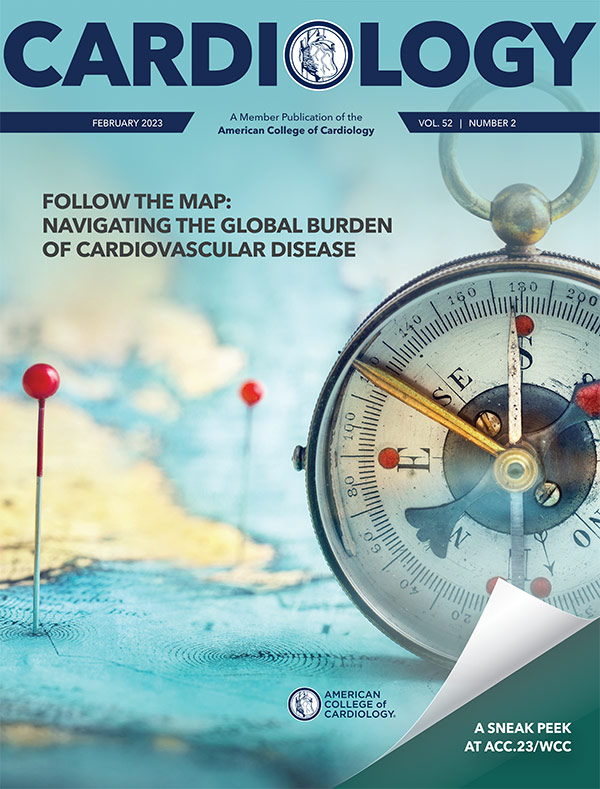Journal Wrap

The hottest research from various peer-reviewed journals – handpicked weekly by the ACC.org Editorial Board led by Kim A. Eagle, MD, MACC.
Underuse of Bariatric Surgery Among Patients With Obesity and Diabetes
Less than 2% of outpatients with obesity and diabetes and potentially eligible for bariatric surgery underwent the procedure, according to a study published in the International Journal of Obesity.
Priya Jain, MD, et al., found that among 1,544,163 patients from the Veradigm Metabolic Registry, formerly the Diabetes Collaborative Registry, 462,033 (30.4%) were BMI-eligible for bariatric surgery. Of those eligible (mean age, 59.4 years, 56% women; 82.1% White; mean BMI, 40.6 kg/m2; mean HbA1c, 7.1; insulin-treatment, 25.8%), only 6,310 patients (1.6%) received the therapy over a median follow-up of 854 days. Most (77%) had hypertension and nearly half were being treated with two or more antihypertensive drugs. Their mean LDL-C was 98.5 mg/dL and half were taking a statin and a quarter had CAD.
Patients who had bariatric surgery, compared with those who did not, were more likely to be female (63% vs. 56%), White (87% vs. 82%), have higher body mass indices (42.1 ± 6.9 vs. 40.6 ± 5.9 kg/m2), and depression (23% vs. 14%). Results showed that patients who had bariatric surgery had an average weight loss of 11.8 ± 18.5 kg and their use of medications was reduced: 10.2% were on fewer glucose-lowering medications and 8.4% were on fewer antihypertensives. The median post-surgery follow-up was 722 days.
The researchers note that while bariatric surgery has become safer and more accessible over the last two decades, its use continues to be low, with fewer than one of 50 patients with obesity and diabetes in this study receiving this treatment. "Given the large proportion of patients potentially eligible for metabolic surgery, our study demonstrates a substantial missed opportunity to impact weight loss, diabetes management, and cardiovascular risk factor control," they write.
While the reason for this underuse is unclear, the researchers note that physicians may be discounting some patients due to certain cardiovascular risk factors and comorbidities. "With improvement in safety of bariatric surgery, physicians may need to recalibrate the type of patient considered eligible for bariatric surgery, with a focus on net clinical benefit," they write.
Jain P, Hejjaji V, Thomas MB, et al. Intl J Obes 2022;46:2163-7.
Secondary Prevention Lags For Patients With T2D and Cerebrovascular Disease
Patients with type 2 diabetes (T2D) and isolated cerebrovascular disease (CeVD) have the lowest rates of attaining secondary cardiovascular prevention goals, compared with patients with T2D and coronary artery disease (CAD) or peripheral artery disease (PAD) or CeVD plus CAD/PAD, according to a study published in The American Journal of Medicine.
With data from the Veradigm Metabolic Registry, formerly the Diabetes Collaborative Registry, Justin B. Echouffo-Tcheugui, MD, PhD, et al., looked at 727,467 outpatients with T2D and cardiovascular disease from 2014 to 2018 to determine the use of guideline-recommended therapy in patients with T2D and isolated CeVD. Researchers divided the patients into three groups: isolated CeVD (n=99,777), CeVD plus CAD/PAD (n=158,361), and isolated CAD/PAD (n=469,329).
Results showed that patients with isolated CeVD, compared with those with isolated CAD/PAD, were more likely to have a hemoglobin A1c <8% (adjusted relative risk [aRR], 1.10), but they were less likely to have controlled BP ≤130/80 mm Hg (aRR, 0.93). They were also less likely to have been prescribed antithrombotics (aRR, 0.84), statins (aRR, 0.86), GLP-1 agonists (aRR, 0.75), SGLT2 inhibitors (aRR, 0.73) and TZDs (aRR, 0.76). This underuse of guideline-recommended secondary preventative therapies was not observed in patients who additionally had CAD/PAD.
Of note, being under the care of a cardiologist, compared with other specialties, was associated with a tendency for better goal attainment among patients with isolated CeVD.
According to Echouffo-Tcheugui, et al., more focus is required to provide appropriate secondary prevention strategies to patients with T2D and isolated CeVD, emphasizing the need for collaboration among clinicians treating these cases. They state there is a pressing need for guideline and position statements to emphasize aggressive secondary prevention strategies for this population.
"Patients with cerebrovascular disease are at high risk for recurrent stroke as well as other ischemic/vascular events, and so aggressive secondary prevention efforts are imperative after cerebrovascular events," they state. "As ~30% of stroke patients have diabetes, there is tremendous opportunity for cross-specialty collaboration between neurologists and endocrinologists, who have not traditionally co-managed patients."
Echouffo-Tcheugui JB, Turchin A, Rosenson RS et al. Am J Med 2022;135:1336-41.
NYHA Classification May Be Incomplete Predictor of Adverse Outcomes in HF
The NYHA classification for heart failure (HF) may miss patients with a physician-defined "asymptomatic" functional class who are at substantial risk for adverse outcomes, according to a study published in JAMA Cardiology.
Luis E. Rohde, MD ScD, et al., conducted a secondary analysis of 8,326 patients from the PARADIGM-HF trial to assess the association between NYHA class and long-term prognosis. All patients were in NYHA class II or higher HF at baseline and were treated with sacubitril-valsartan during a six-to-10-week run-in period before randomization.
Results showed that of 389 patients in NYHA class I at randomization, 228 (58%) changed functional class after the first year. Patients classified as NYHA class III had a higher rate of cardiovascular events (NYHA class III vs. class I, hazard ratio [HR], 1.84; NYHA class III vs. class II, HR, 1.49). Conversely, NYHA class I and class II patients had lower event rates (NYHA class II vs. class I, HR, 1.24).
The level of NT-proBNP was found to be a poor discriminator for NYHA class. For NYHA class I vs. class II, the area under the curve was 0.51. NT-proBNP level estimated kernel density overlap was 93% for NYHA class I vs. class II, 79% for class I vs. class III, and 83% for class II vs. class III.
Stratification of NT-proBNP levels (<1600 pg/mL or ≥1600 pg/mL) found subgroups with distinctive risk, such that patients with NYHA class I and high NT-proBNP levels (n=175) had a numerically higher event rate than patients with low NT-proBNP levels from any NYHA class (vs. class I, HR, 3.43; vs. class II, HR, 2.12; vs. class III, HR, 1.37).
The authors write their findings challenge the NYHA framework, and "suggest that novel criteria must be considered in selecting patients who may benefit most from modern HF therapies. It is reasonable to propose that apparently asymptomatic HF patients defined by subjective assessments should be "challenged" by patient-reported scores…"
Rohde LE, Zimerman A, Vaduganathan M, et al. JAMA Cardiol 2022;Dec 7:[Epub ahead of print].
Clinical Topics: Diabetes and Cardiometabolic Disease, Heart Failure and Cardiomyopathies, Prevention, Valvular Heart Disease, Vascular Medicine, Acute Heart Failure
Keywords: ACC Publications, Cardiology Magazine, Metabolic Syndrome, Heart Valve Diseases, Obesity, Aneurysm, Diabetes Collaborative Registry, Secondary Prevention, Heart Failure
< Back to Listings

